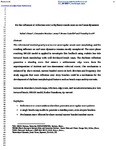On the influence of reflection over a rhythmic swash zone on surf zone dynamics
| dc.contributor.author | Almar, R | |
| dc.contributor.author | Nicolae Lerma, A | |
| dc.contributor.author | Castelle, B | |
| dc.contributor.author | Scott, Tim | |
| dc.date.accessioned | 2018-08-08T16:10:02Z | |
| dc.date.issued | 2018-07 | |
| dc.identifier.issn | 1616-7341 | |
| dc.identifier.issn | 1616-7228 | |
| dc.identifier.uri | http://hdl.handle.net/10026.1/11994 | |
| dc.description.abstract |
The reflection of incident gravity waves over an irregular swash zone morphology and the resulting influence on surf zone dynamics remains mostly unexplored. The wave-phase resolving SWASH model is applied to investigate this feedback using realistic low-tide terraced beach morphology with well-developed beach cusps. The rhythmic reflection generates a standing wave that mimics a subharmonic edge wave, from the superimposition of incident and two-dimensional reflected waves. This mechanism is enhanced by shore-normal, narrow-banded waves in both direction and frequency. Our study suggests that wave reflection over steep beaches could be a mechanism for the development of rhythmic morphological features such as beach cusps and rip currents. | |
| dc.format.extent | 899-909 | |
| dc.language | en | |
| dc.language.iso | en | |
| dc.publisher | Springer Science and Business Media LLC | |
| dc.subject | Nearshore | |
| dc.subject | Beach cusps | |
| dc.subject | Reflection | |
| dc.subject | Edge wave | |
| dc.subject | Surf-swash interactions | |
| dc.subject | Low-tide terraced beach | |
| dc.subject | SWASH model | |
| dc.subject | Radon transform | |
| dc.subject | Rip current | |
| dc.title | On the influence of reflection over a rhythmic swash zone on surf zone dynamics | |
| dc.type | journal-article | |
| dc.type | Journal Article | |
| plymouth.author-url | https://www.webofscience.com/api/gateway?GWVersion=2&SrcApp=PARTNER_APP&SrcAuth=LinksAMR&KeyUT=WOS:000435673500009&DestLinkType=FullRecord&DestApp=ALL_WOS&UsrCustomerID=11bb513d99f797142bcfeffcc58ea008 | |
| plymouth.issue | 7 | |
| plymouth.volume | 68 | |
| plymouth.publication-status | Published | |
| plymouth.journal | Ocean Dynamics | |
| dc.identifier.doi | 10.1007/s10236-018-1165-5 | |
| plymouth.organisational-group | /Plymouth | |
| plymouth.organisational-group | /Plymouth/Faculty of Science and Engineering | |
| plymouth.organisational-group | /Plymouth/Faculty of Science and Engineering/School of Biological and Marine Sciences | |
| plymouth.organisational-group | /Plymouth/REF 2021 Researchers by UoA | |
| plymouth.organisational-group | /Plymouth/REF 2021 Researchers by UoA/UoA07 Earth Systems and Environmental Sciences | |
| plymouth.organisational-group | /Plymouth/Users by role | |
| plymouth.organisational-group | /Plymouth/Users by role/Academics | |
| dcterms.dateAccepted | 2018-05-08 | |
| dc.rights.embargodate | 2019-5-22 | |
| dc.identifier.eissn | 1616-7228 | |
| dc.rights.embargoperiod | Not known | |
| rioxxterms.versionofrecord | 10.1007/s10236-018-1165-5 | |
| rioxxterms.licenseref.uri | http://www.rioxx.net/licenses/all-rights-reserved | |
| rioxxterms.licenseref.startdate | 2018-07 | |
| rioxxterms.type | Journal Article/Review |


